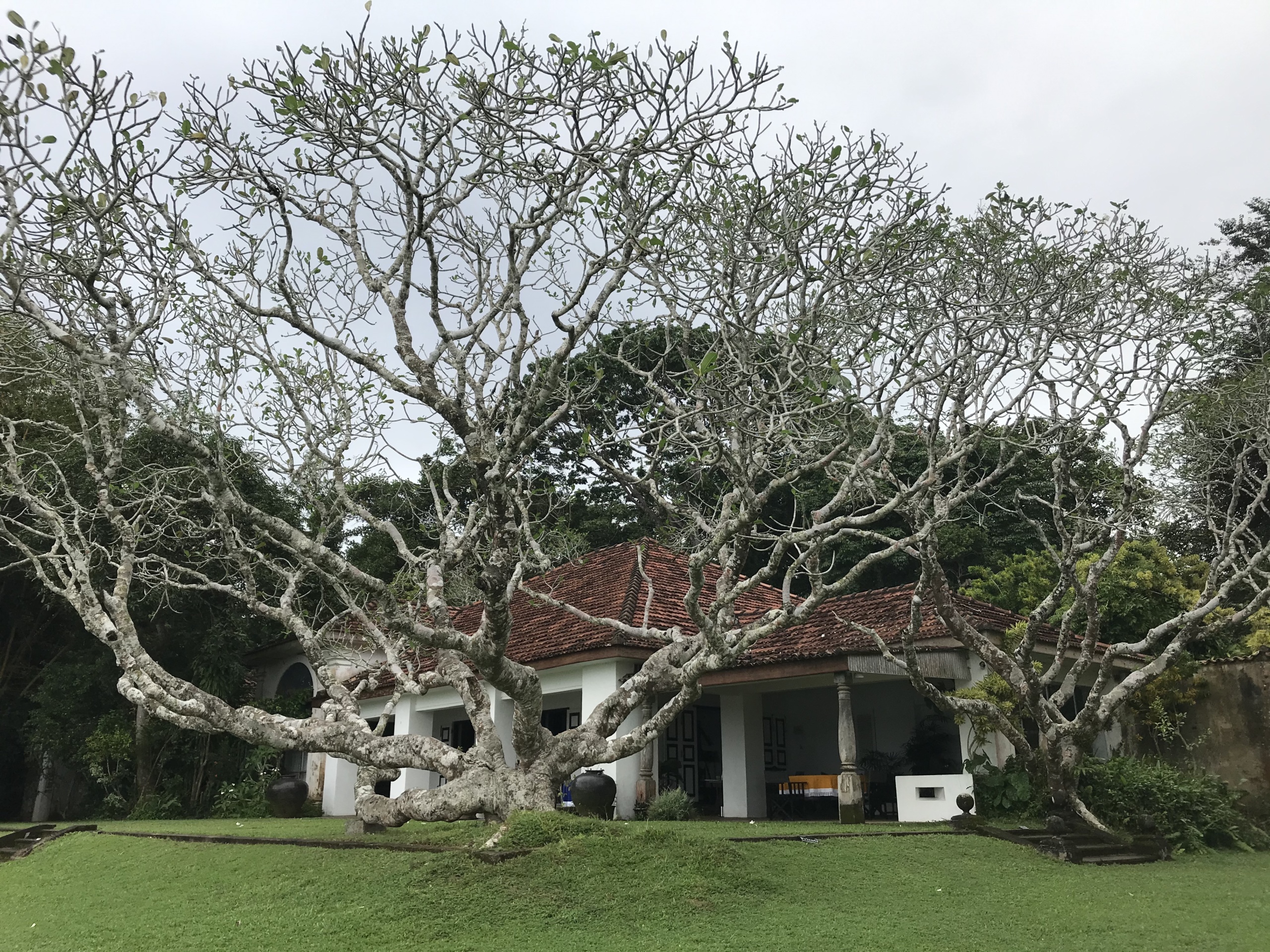
At Lunuganga, my guide Nuwan tells me that, as a child, he once visited Geoffrey Bawa’s estate for a devil dance. The Sri Lankan architect, now considered one of the fathers of Tropical Modernism, was first known to Nuwan and others in his village as an eccentric, exceedingly private gentleman who owned the sprawling fifteen-acre estate known as Lunuganga.
I asked Nuwan what Bawa was like. “Very tall,” he responded immediately. “And very fair—foreign-coloured.”
He shows me a spot in the garden opposite a copse of bamboo trees and says that this is where the villagers gathered for the devil dance, at Bawa’s invitation, having crossed the river between Lunuganga and the neighboring village in rowboats.
“Mr. Bawa was here,” Nuwan points. “He was in a wheelchair at the time.” I assume that this occurred in the later stage of Bawa’s life, when a series of strokes rendered the great architect paralysed and unable to speak, requiring him to move around in a battery-powered wheelchair.
Bawa bought Lunuganga in 1948, the same year that Sri Lanka, then Ceylon, gained independence from British colonial rule. Over the course of his life, Bawa cultivated what was originally an abandoned rubber estate into the idyllic, Arcadian landscape that it is today. Wandering the grounds, it is easy to see why Bawa’s work is considered one of Sri Lanka’s most prominent aesthetic influences. In what is perhaps its most ubiquitous characteristic, Lunuganga easily blurs the distinction between the interior of the domicile and the landscape around it: a delicately placed velvet tête-à-tête sits adjacent to a sun-mottled interior courtyard; massive wooden doors open into a sprawling garden overlooking the river; a double height loggia allows for a moment of stillness, surrounded by the low flutes of bird song.
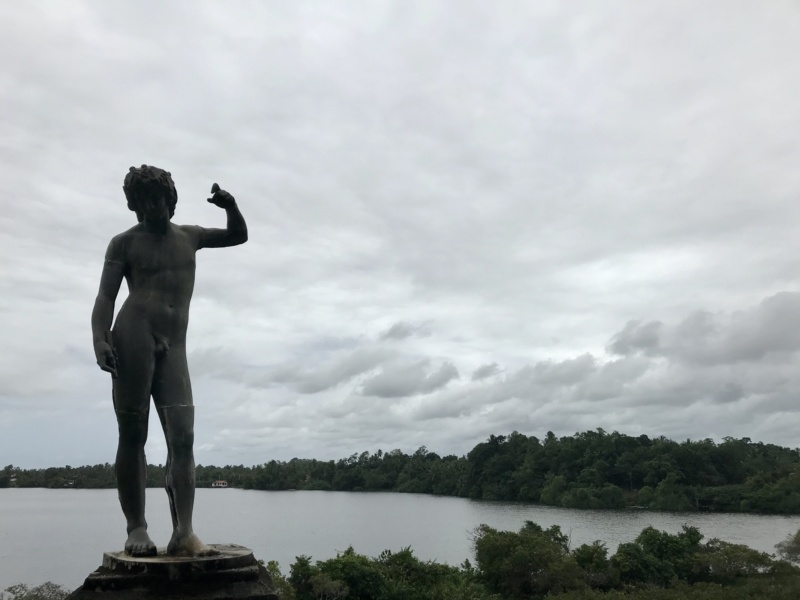
Outside, Nuwan leads me to “The Black Pavilion,” an exquisitely crafted pond in the shape of a butterfly. A walkway with a sundial makes up the body, complete with an elevated sitting area at its head, where he tells me Bawa liked to read in the mornings.
A little further ahead, we reach a bench overlooking the river, a stone statue of a leopard sitting placidly right by the water. This, I find out, is where Bawa and his guests—ranging from the Australian artist Donald Friend to the Danish architect Ulrik Plesner—enjoyed a smoke as they watched the brilliant cinema that is a tropical sunset unfold. As we walk, we find a series of bells coyly situated at arm’s reach, hanging from trees or positioned over wells. Each bell has a distinctive sound, as each was rung to request a specific comfort, whether lunch, an evening gin and tonic or a cup of afternoon tea. Evidently, Lunuganga was a place made with a particular kind of living in mind; it is an exercise in carefully-curated aesthetics which, of course, are a necessary cousin to indulgence.
As we walk around Lunuganga, I think of another very tall, very fair, “foreign-coloured” gentleman: the writer Michael Ondaatje, a friend of Bawa’s who, like the architect himself, was Sri Lankan of Eurasian descent. In his memoir detailing his childhood in Sri Lanka, Ondaajte writes about the lives of a privileged group of Ceylonese elites who, after horse races in Colombo, often drove drunkenly to sprawling estates like Lunuganga, where they downed oysters with champagne if they won and wine if they lost. Ondaatje describes one of these trips to Ambalangoda, a town a hundred kilometers from Colombo much like the one Lunuganga is located in. Ambalangoda, Ondaatje writes, “was the centre for devil dances and exorcism rites,” although for his characters, these were not the primary appeals of this languid fishing village. Instead, this is where “men leaned their chins against the serene necks of the women, danced a waltz or two, slid oysters into their partners’ mouths. The waves on the beach collected champagne corks. Men who had lost fortunes laughed frantically into the night. A woman from the village who was encountered carrying a basket of pineapples was persuaded to trade that for a watch removed from a wrist.”
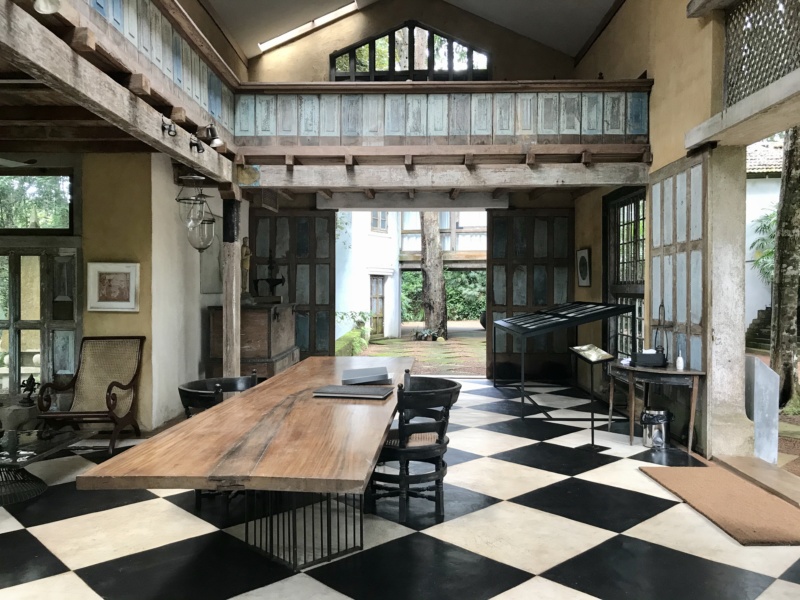
“This charmed group,” Ondaatje describes, “was part of another lost world”.
Though Ondaatje was writing about Ambalangoda, I could very well picture the same scene at Lunuganga—to imagine the water lapping against the shore, accompanied by laughter and the sound of a waltz at midnight does not seem too far-fetched here.
A “lost world” is an apt descriptor for Lunuganga. We sit on a bench that overlooks the Dedduwa Lake, flanked by two miniature statues of David purchased in Italy and assembled in Sri Lanka. I feel like I am looking out over a sun drenched Mediterranean villa; it is only the realities of the landscape—the frangipani trees, the sight of a Buddhist temple across the lake, a well shaped like a bo leaf—that bring me back to where I am. Lunuganga evokes a sense of overwhelming nostalgia—and for good reason. Before his mother’s illness brought him down to Sri Lanka, the British-educated Bawa had contemplated buying and settling down in a villa overlooking Lake Garda in Italy. It is this particular longing, this nod to the possibility of other homes on other shores, that Lunuganga so cleverly evokes.
As we walk, Nuwan points out details I might have otherwise missed: a Burmese gong in the shape of a cow’s head, a bust of Pan leering over a lotus pond, a windmill over what looks like an English castle and Chinese ritual wine vessels spaced evenly along the lawn, all finding their place in the distinctly Sri Lankan topography around us. This pluralist approach to architecture— and, specifically, the merging of vernacular aesthetics with the formal qualities of European modernism—was what defined Bawa’s conception of Tropical Modernist design. This is especially evident in a house that Bawa designed for his friend Ena de Silva, a prominent batik artist, in 1962. One of his most celebrated works, the Ena de Silva house is lauded by critics as drawing on the often-forgotten conventions of the colonial manor, the Dutch courtyard and the Moor Muslim row house to create an innovative architectural language for urban living in dense, tropical surroundings. In fact, in a lecture about Bawa’s work, the architect Channa Daswatte (Bawa’s close friend, partner and one of Sri Lanka’s most distinguished architects in his own right) said that it was really via Bawa’s designs for private residences that he truly brought modernism to Sri Lanka.
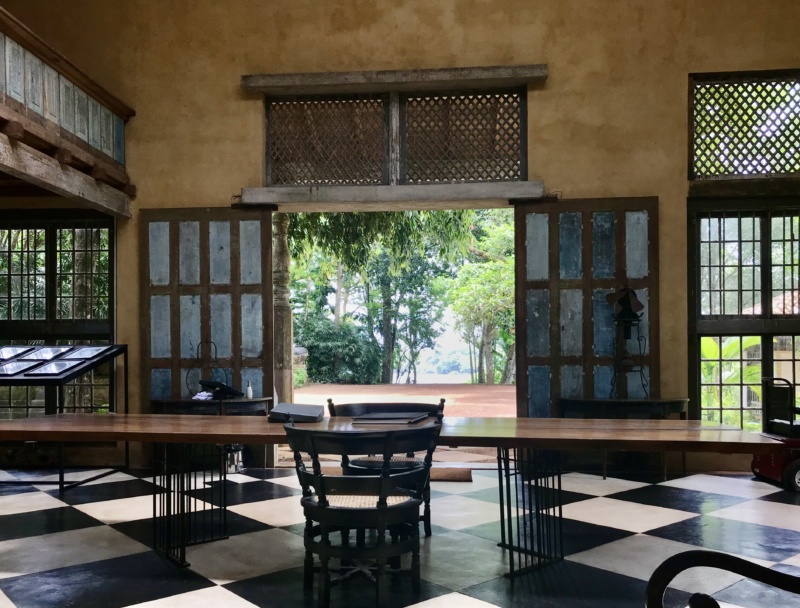
At the gatehouse loggia, there is a mural by the Sri Lankan artist Laki Senanayake depicting a fight scene from the ancient Hindu epic The Ramayana. It feels quite reminiscent of another spectacular work of art by Senanayake: a meticulously crafted iron staircase featuring a battle between the native Sri Lankans and their Portuguese colonizers at The Lighthouse hotel in Galle—a building designed, of course, by Bawa. Senanayake’s work—along with that of many other prominent Sri Lankan artists—dots the premises at Lunuganga, as is often also the case at Bawa’s other commissions. It is a reminder that Bawa saw architecture as a conversation among artists and that every building is an evolving tapestry, a multi-layered text.
Ondaatje wrote in a tribute to Bawa that, “Every artist works on a different scale. A page. A painting. A sonata. A film. A novel. A house. A garden. But essentially they all create, in some ways, self-portraits of themselves. Art is a long intimacy. The scale of the achievement might be grand and take years but it has to be personal and carefully pieced together and specific to its culture.”
Lunuganga certainly feels like a self-portrait. To explore its meticulously designed landscape is to understand what Bawa paid attention to and, by extension, what he might have loved. Signs of his bold, maverick personality are everywhere: I came across a small shuttered window located halfway down an otherwise blank wall. It turned out to be a window situated at eye height for someone sitting on the commode, in the event they should want to enjoy the rambling vistas of the garden while on the toilet. Elsewhere, in front of the main house, is a massive frangipani tree. I learn that this is the result of two trees being grafted together, one weighted down to train the branches to curve gently downwards, hovering just inches above the manicured lawn. As the curator of The Bawa Trust, Shayari de Silva, said in an interview, Bawa “literally moved mountains to create the slopes and views that he wanted.”
Everywhere, we are surrounded by water. This is not uncommon, given that we are in Sri Lanka, an island, of course, nor is this a departure from Bawa’s general body of work. From the Parliament that he built for the newly independent state in 1982 to the private residences that he designed, water plays a prominent feature in his architecture, whether by flooding a marsh to form his vision of an “island capitol” for the Parliament or through the ornamental terracing that decorated many of his beachside resorts. Still, we are in Bentota, the southern coastal location of Lunuganga and a town ravaged by the 2004 tsunami that devastated Sri Lanka and many others in the Indian Ocean. Seeing the water lapping at our feet makes me nervous; it makes me think back to the little villages that we passed on the southern coast, on our way to Lunuganga—how so many of them are still recovering from the impact of the tsunami, even now, sixteen years later.
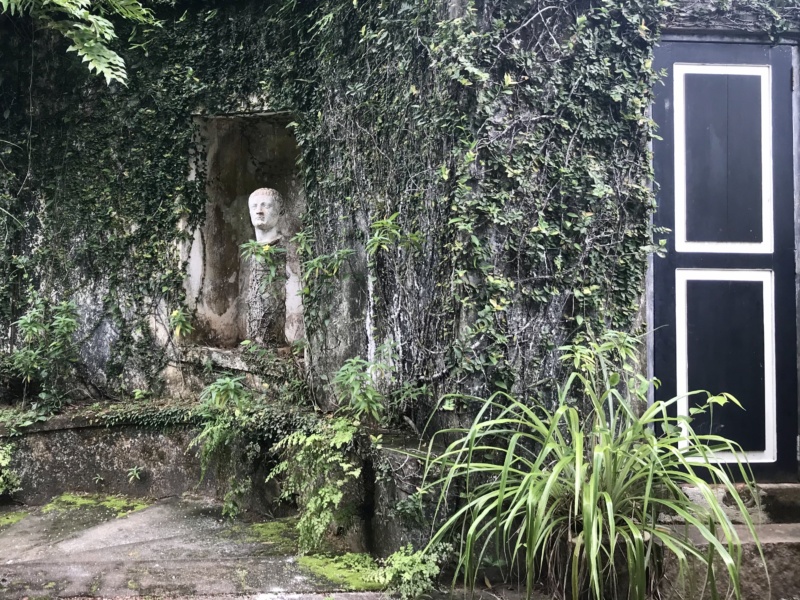
I ask Nuwan whether the tsunami ever hit Lunuganga. “No,” he tells me. “We were lucky—it was too far inland to really affect us.” And, certainly, in some ways Lunuganga feels like a world of its own. In a book published about the residence, Bawa recounts an anecdote of a lorry driver dropping off some timber, who stopped to remark that “this is a seedevi place.” A blessed place. The kind of place that invites you to linger, where the troubles of the world are kept at bay—either by artifice or by circumstance—and the pleasures of the senses are made keenly manifest.
In an essay on hybridity in art, Ondaatje writes that “Bawa was a gracious and gregarious man. He had wit and courtesy, but he was also difficult and private. In some way Lunuganga represents both sides of him. He made no attempt to turn it into a pompous estate… Each vista, each location feels like another elegy or another voice—the first person, then the third person, the vernacular, then the classical. You discover you wish to be at one location at noon, another at twilight, some when you are young, others later in life.”
The idea of Lunuganga as an elegy feels strangely prescient. We are half-way up the hill from the main house when Nuwan stops in the dappled shade of a tree and remarks cryptically that “Mr. Bawa is here.”
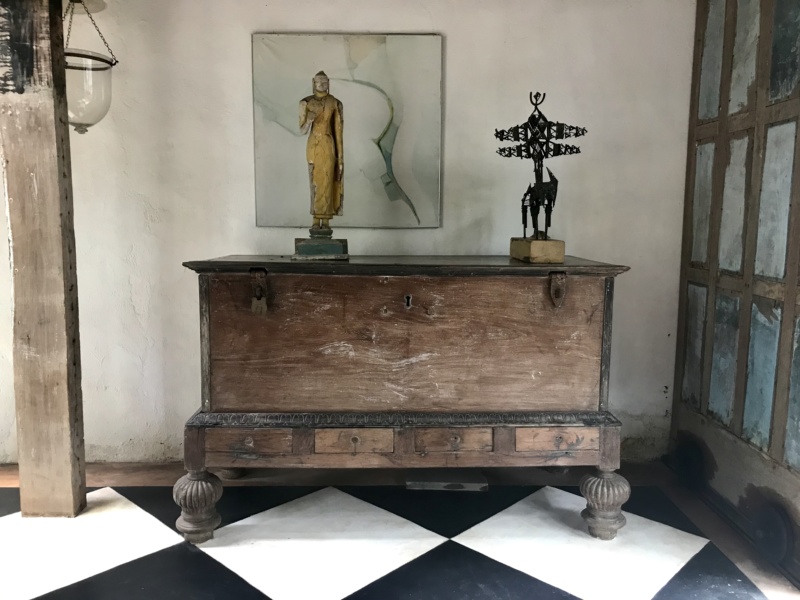
I look around, bemused, wondering if he perhaps meant that a relative of the architect had wandered onto the premises.
“No, here,” Nuwan insists, and points to the ground. There, under a small, grey stone, are the late Geoffrey Bawa’s ashes. There is no tombstone, no plaque, no marker aside from an unassuming stone on the ground to point to Bawa’s final resting place, on a hill overlooking the river that gave his beloved estate its name.
It is fitting that Bawa chose Lunuganga, the project that he spent his entire life working on, to be laid to rest. It also speaks to the fluidity of Lunuganga’s history, how it, much like the troubled country it called home, went through multiple incarnations and fulfilled a multiplicity of functions, from hosting devil dances to entertaining artists from around the world, transforming, over time, from an abandoned rubber estate to a carefully maintained private retreat that invites visitors to experience the great architect’s life and legacy in the way he would have wanted you to—with a slow, unhurried stroll through the landscape that he so loved, stopping, once in a while, for a coffee, a gin, a smoke, as the sun sets over the silvered waters of the Dedduwa Lake.

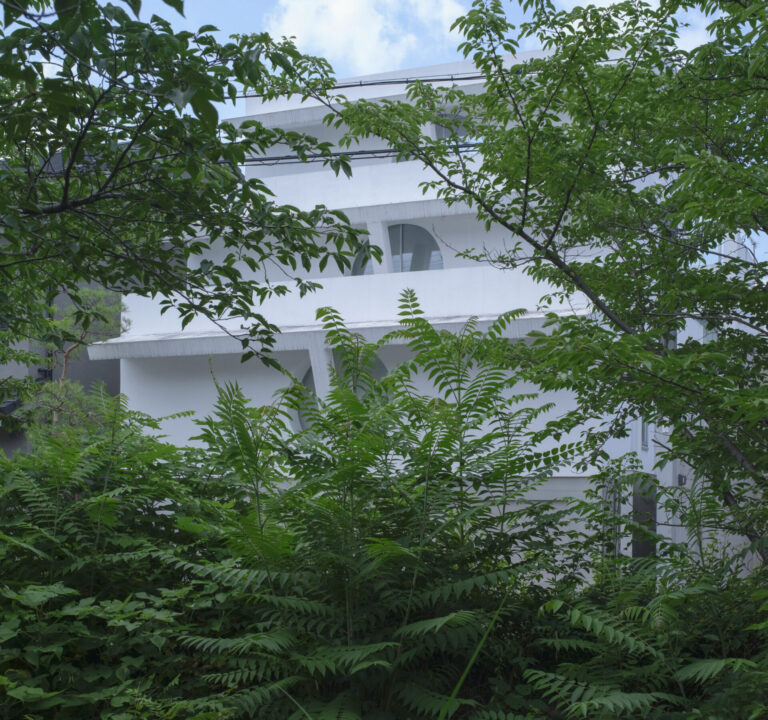
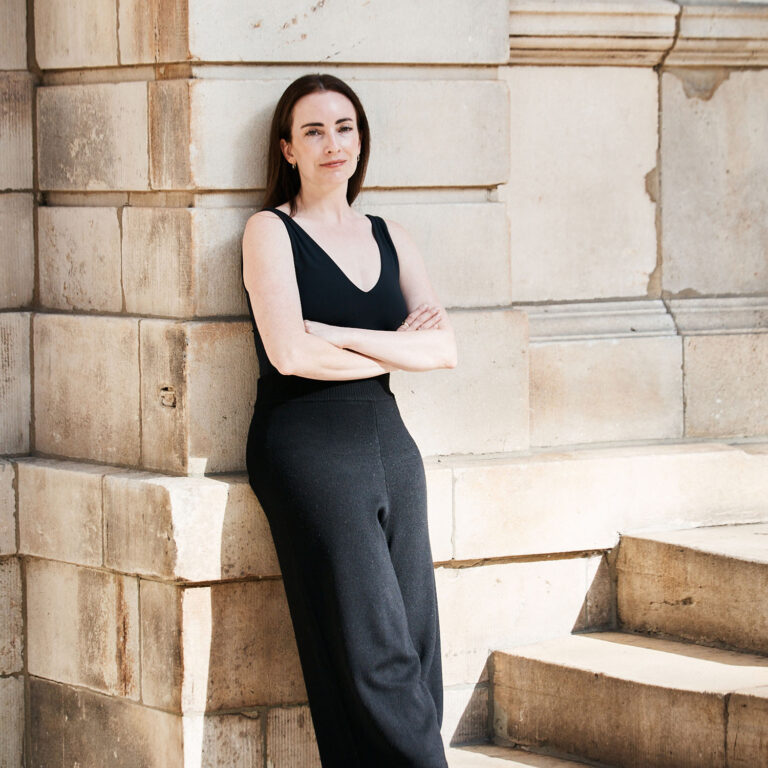

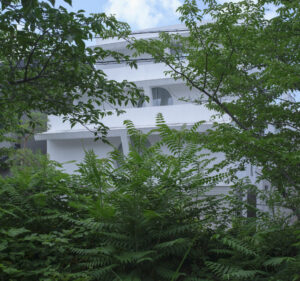
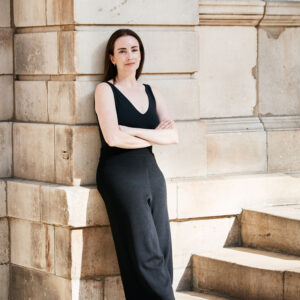




 in your life?
in your life?

